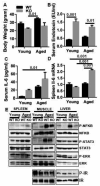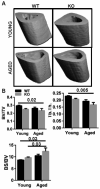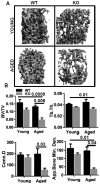Aging amplifies multiple phenotypic defects in mice with zinc transporter Zip14 (Slc39a14) deletion
- PMID: 27647172
- PMCID: PMC5101137
- DOI: 10.1016/j.exger.2016.09.013
Aging amplifies multiple phenotypic defects in mice with zinc transporter Zip14 (Slc39a14) deletion
Abstract
Inflammation and zinc dyshomeostasis are two common hallmarks of aging. A major zinc transporter ZIP14 (slc39a14) is upregulated by proinflammatory stimuli, e.g. interleukin-6. We have evaluated the influence of age on the Zip14 KO phenotype using wild-type (WT) and Zip14 knockout (KO) mice. Aging produced a major increase in serum IL-6 concentrations that was dramatically augmented in the Zip14 KO mice. In keeping with enhanced serum IL-6 concentrations, aging produced tissue-specific increases in zinc concentration of skeletal muscle and white adipose tissue. Metabolic endotoxemia produced by Zip14 ablation is maintained in aged KO mice. Muscle non-heme iron (NHI) was increased in aged WT mice but not in aged Zip14 KO mice demonstrating NHI uptake by muscle is ZIP14-dependent and increases with age. NF-κB and STAT3 activation was greater in aged mice, but was tissue specific and inversely related to tissue zinc. Micro-CT analysis revealed that Zip14 KO mice had markedly reduced trabecular bone that was greatly amplified with aging. These results demonstrate that the inflammation-responsive zinc transporter ZIP14 has phenotypic effects that are amplified with aging.
Keywords: Bone; Growth; Inflammation; Interleukin-6; Sarcopenia; Signaling pathways.
Copyright © 2016 Elsevier Inc. All rights reserved.
Figures






References
-
- Begum NA, Kobayashi M, Moriwaki Y, Matsumoto M, Toyoshima K, Seya T. Mycobacterium bovis BCG cell wall and lipopolysaccharide induce a novel gene, BIGM103, encoding a 7-TM protein: identification of a new protein family having Zn-transporter and Zn-metalloprotease signatures. Genomics. 2002;80:630–645. - PubMed
-
- Bennermo M, Held C, Stemme S, Ericsson CG, Silveira A, Green F, Tornvall P. Genetic predisposition of the interleukin-6 response to inflammation: implications for a variety of major diseases? Clin chem. 2004;50:2136–2140. - PubMed
-
- Besecker B, Bao S, Bohacova B, Papp A, Sadee W, Knoell DL. The human zinc transporter SLC39A8 (Zip8) is critical in zinc-mediated cytoprotection in lung epithelia. Am J Physiol Lung Cell Mol Physiol. 2008;294:L1127–1136. - PubMed
Publication types
MeSH terms
Substances
Grants and funding
LinkOut - more resources
Full Text Sources
Other Literature Sources
Medical
Research Materials
Miscellaneous

